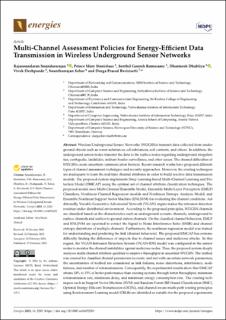| dc.description.abstract | Wireless Underground Sensor Networks (WUGSNs) transmit data collected from underground objects such as water substances, oil substances, soil contents, and others. In addition, the underground sensor nodes transmit the data to the surface nodes regarding underground irregularities, earthquake, landslides, military border surveillance, and other issues. The channel difficulties of WUGSNs create uncertain communication barriers. Recent research works have proposed different types of channel assessment techniques and security approaches. Moreover, the existing techniques are inadequate to learn the real-time channel attributes in order to build reactive data transmission models. The proposed system implements Deep Learning-based Multi-Channel Learning and Protection Model (DMCAP) using the optimal set of channel attribute classification techniques. The proposed model uses Multi-Channel Ensemble Model, Ensemble Multi-Layer Perceptron (EMLP) Classifiers, Nonlinear Channel Regression models and Nonlinear Entropy Analysis Model, and Ensemble Nonlinear Support Vector Machine (ENLSVM) for evaluating the channel conditions. Additionally, Variable Generative Adversarial Network (VGAN) engine makes the intrusion detection routines under distributed environment. According to the proposed principles, WUGSN channels are classified based on the characteristics such as underground acoustic channels, underground to surface channels and surface to ground station channels. On the classified channel behaviors, EMLP and ENLSVM are operated to extract the Signal to Noise Interference Ratio (SNIR) and channel entropy distortions of multiple channels. Furthermore, the nonlinear regression model was trained for understanding and predicting the link (channel behaviors). The proposed DMCAP has extreme difficulty finding the differences of impacts due to channel issues and malicious attacks. In this regard, the VGAN-Intrusion Detection System (VGAN-IDS) model was configured in the sensor nodes to monitor the channel instabilities against malicious nodes. Thus, the proposed system deeply analyzes multi-channel attribute qualities to improve throughput in uncertain WUGSN. The testbed was created for classified channel parameters (acoustic and air) with uncertain network parameters; the uncertainties of testbed are considered as link failures, noise distortions, interference, node failures, and number of retransmissions. Consequently, the experimental results show that DMCAP attains 10% to 15% of better performance than existing systems through better throughput, minimum retransmission rate, minimum delay, and minimum energy consumption rate. The existing techniques such as Support Vector Machine (SVM) and Random Forest (RF)-based Classification (SMC), Optimal Energy-Efficient Transmission (OETN), and channel-aware multi-path routing principles using Reinforcement Learning model (CRLR) are identified as suitable for the proposed experiments. | en_US |

